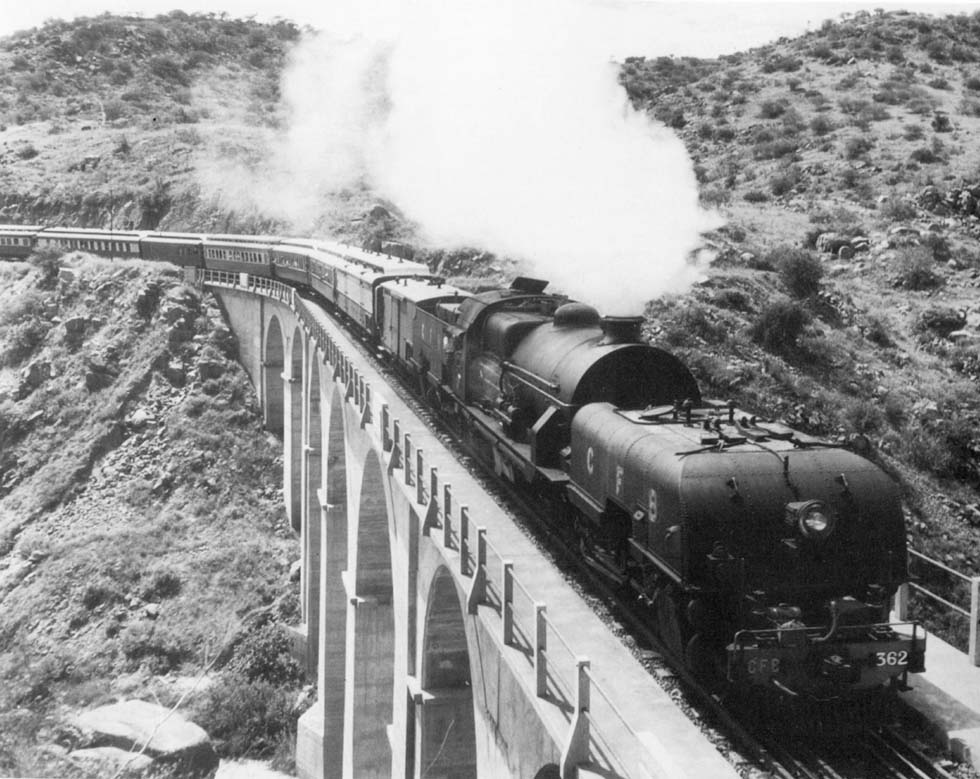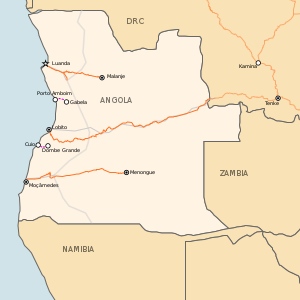Benguela railway
The Benguela railway (Portuguese Caminho de Ferro de Benguela ) is a railway line in Africa narrow gauge of 1067 mm ( Cape gauge ). It leads from the Angolan port of Lobito Benguela over to Katanga in the Democratic Republic of Congo. The track belongs to the national railway company Caminhos de Ferro de Angola.
The Benguela and their connecting lines
The Atlantic port of Lobito in Angola's Benguela province is the starting point of the 1344 km long Benguela, Lobito with the Dilolo in Katanga in the Democratic Republic of Congo connects.
From there, the rail network of the Société Nationale des Chemins de fer du Congo via Kasumbalesa by Zambia to the network of Zambia Railways and Kitwe - Lusaka - Livingstone to Zimbabwe to the network of the National Railways of Zimbabwe and on to the network of Caminhos de Ferro de Moçambique to to Beira in Mozambique, a port on the Indian Ocean. Even after South Africa to the network of Transnet Freight Rail consist of connections there. In Kapiri Mposhi in Zambia is a compound of TAZARA to Dar es Salaam in Tanzania and thus also to the Indian Ocean.
History
The Portuguese government initiated in 1899 the construction of the railway to serve the hinterland and the mineral-rich Belgian Congo. 1902 took over the Briton Sir Robert Williams, a friend of Cecil Rhodes, the construction and completed by 1929, the compound according to Luau on the border with Congo. The track quickly proved profitable, although trains took up to three days for the journey. The steam locomotives, mostly of type Garratt were fired with eucalyptus wood, which was won in large railway-owned plantations.
Until 1948, there were east of Benguela a particularly steep section, which could only be met by Riggenbach - gear drive with Lengue. This was replaced with a bypass line with a lower slope.
1972 began work on the variant do Cubal that linked the port of Lobito on a main route leading north of the route with Cubal. This route had fewer curves and significantly larger curve radii and was about 40 kilometers shorter. In October 1974, the new line was opened, just before the independence of Angola. At the same time, most steam locomotives were replaced by diesel locomotives from General Electric. In almost immediately following the Angolan Civil War, the route due to its strategic importance has been the target of attacks. She was largely destroyed. Most locomotives had in 2001 only scrap value; the covered wagon served humans as property.
Until 20 September 2006, the 478 km long stretch of the Benguela railway was taken in the section between Lobito and Katchiungo in central Angola on the variant do Cubal again. The People's Republic of China invested several hundred million U.S. dollars for the full reopening of the 1344 km long route.
The company is managed since June 2010, by Dr. Carlos Gomes, the former director general of the port of Lobito.
Restore the entire route until 2012
The reconstruction of the route between Munhango and Luau launched in February 2009 and by the Chinese construction company China Railway 20 Bureau Group Corporation (CR -20 ) was passed. The route Benguela Huambo was released on 30 August 2011 for the traffic.
In November, 2005, Daniel Quipache, director of Benguelaeisenbahn, announced that the route Luau is restored. For this purpose, provided the PRC a loan. There are 1301 km of rail to the region of Moxico. The restoration of the railway line was included in the national railway planning with estimated cost of 200 million U.S. dollars and an expected completion by 2012. The plan in addition to the restoration of the route and the Improvement of stations, cars and locomotives before. Since 2005, the following progress of the project were made:
- Calenga - Santa - Iria project: the project provided for the restoration of railway services between Caála and Huambo, was launched in 2006 and is now completed.
- Lobito - Cubal project: the 153 km long line was opened in July 2005 in operation ( including a new bridge at km 79 on the Halu - flow).
- The section Cubal - Huambo was traveled for the first time on 12 June 2011, is completed.
- Luena Luau Project: Located in the completion.
- SITLOB: The Intercity project system for passenger traffic between Lobito and Benguela is in the planning.
Overall, the previous investments in the restoration of the Benguela railway amounted to 1.8 billion U.S. dollars. 20 stations on the line have been restored by 2010.
Gallery
In the center of the Benguela railway line crosses the highway
Station of the Benguela railway in Katumbela










